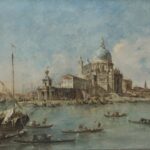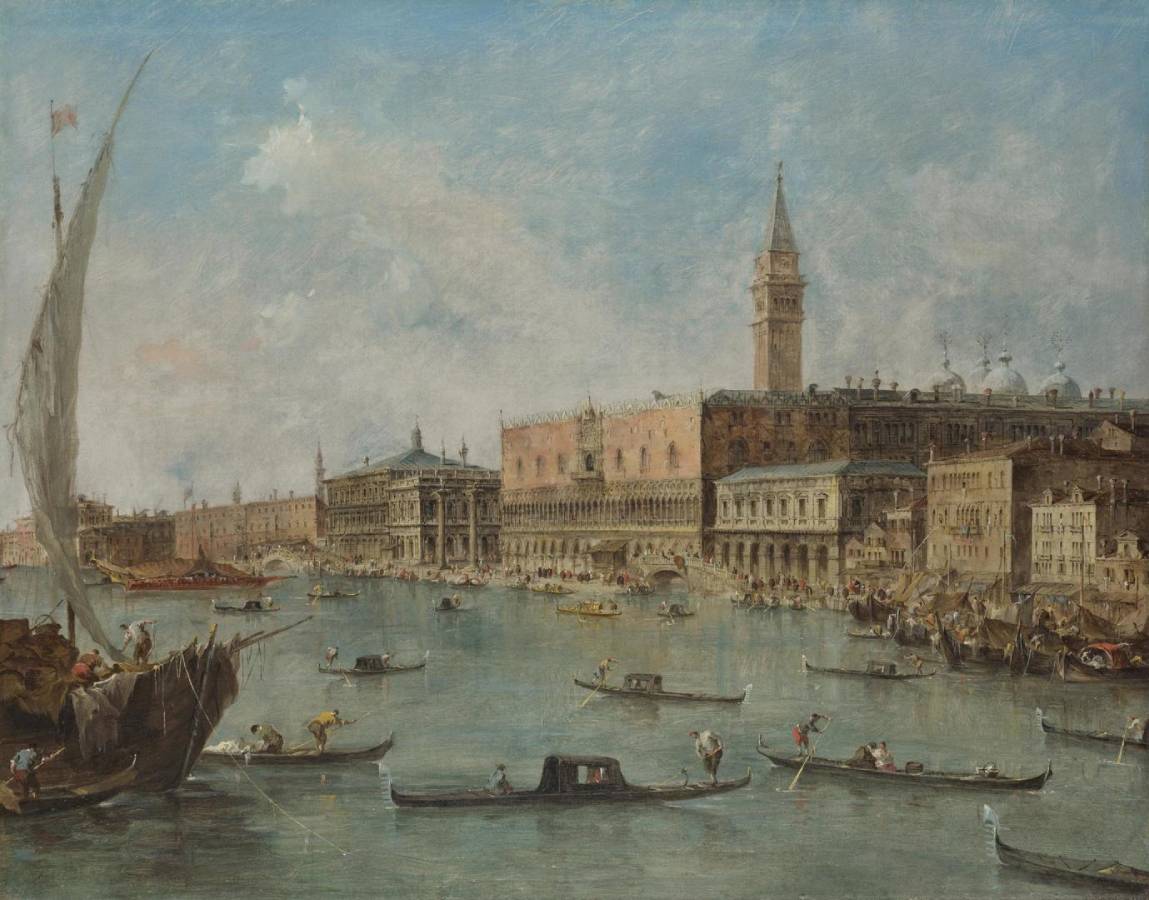Guardi, Francesco (1712-1793)
Il Palazzo Ducale e il Molo dal Bacino di San Marco (Venice: The Doge’s Palace and the Molo from the Basin of San Marco)
c.1770
Oil on canvas, 58.1 × 76.4 cm
National Gallery, London
Guardi delighted in capturing the charm of his beloved Venice, and here he has given the city a soft, powdery appearance and dreamy atmosphere. As in its companion picture, Venice: The Punta della Dogana with S. Maria della Salute, trade is the focus in the foreground of this painting, with Venice’s grand architecture beyond. For centuries, Venice had been a thriving commercial centre and a popular destination on the main trading routes across the Mediterranean; as an island, everything inhabitants needed came by boat.
In the left corner, a large barge filled with goods is at anchor; its sail is being lowered. Guardi frequently framed his scenes using a curved white sail in the foreground, as in Venice: The Guidecca with the Zitelle (he also sometimes used a mast without a sail, like in View of the Venetian Lagoon with the Tower of Malghera). The basin of San Marco and the quayside are a hive of activity. A group of tightly packed fishing boats or trading vessels on the far right almost merge with the shops behind; the men are little more than daubs of colour, but Guardi still managed to portray their industriousness.
Guardi’s figures are not painted in great detail, but they are skilfully placed across the composition to draw the eye in all directions: some row, others sightsee or work. Gondoliers ferry passengers and await clients beside the Molo (a broad stone quay), with the Doge’s Palace and campanile (bell tower) of San Marco, the city’s famous cathedral, beyond. The faint blue domes of the cathedral seem to almost dissolve into the sky. A large galley (state ship) with a gold and red striped awning is moored nearby. This was the vessel used by the doge, the Venetian head of state, on all formal occasions (other than the Ascension Day ceremony, when a much larger boat was commissioned).
Lively brushstrokes evoke the bustle of the city at work, from the movement of boats as they glide across the lagoon to that of the tiny figures dotted along the quayside. Architectural details are merely suggested – on the Doge’s Palace, brown outlines hint at the archways, raised colonnade and ducal gallery above. Different parts of the composition merge into one another: the sky and buildings, the quay with the water, and lagoon with boats and their passengers. (NG)
Companion:
 Guardi, Francesco (1712-1793)
Guardi, Francesco (1712-1793)
La Punta della Dogana con S. Maria della Salute
c.1770
National Gallery, London
Venice: The Doge’s Palace and the Molo from the Basin of San Marco and its companion picture Venice: The Punta della Dogana with S. Maria della Salute were intended to be hung together. Paintings like these were a reminder of Venice’s impressive architecture and bustling atmosphere, and fulfilled a taste for poetic views of the city among locals and foreign collectors.
Guardi shows Venice here as a prosperous city, although by the second half of the eighteenth century the Venetian Republic’s control of the Mediterranean sea trade was growing weaker. For centuries its maritime power had been unrivalled, its economic growth achieved by receiving goods from the east by sea and selling them in the growing European market.
By the 1770s, when these paintings were probably made, Guardi had moved away from the influence of the famed Venetian artist Canaletto in terms of technique. He continued to paint similar parts of the city, but with a more free-handed approach and a particular interest in atmospheric effects. (NG)
